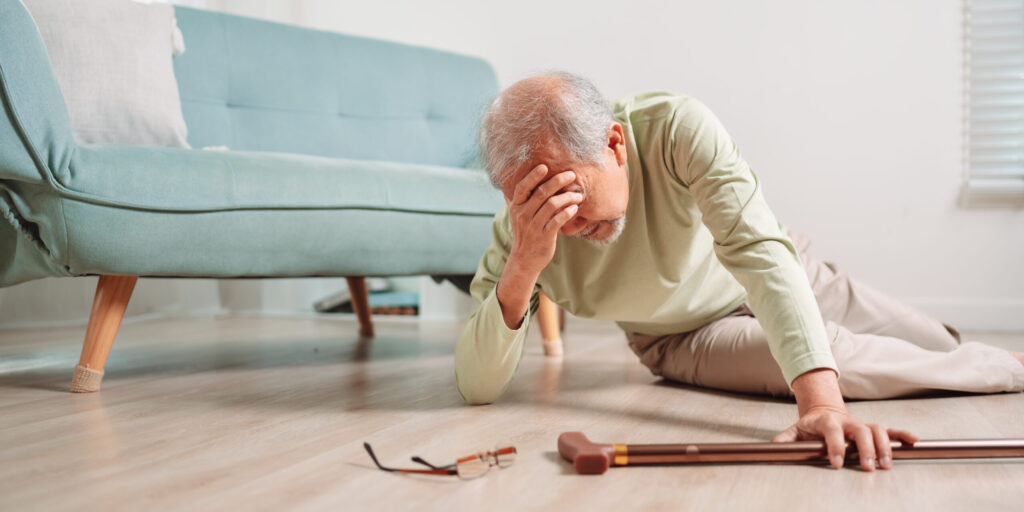
Take Falls Seriously to Prevent Further Injuries
By Christina Medvescak | Tuesday, October 8, 2002
There was a period of time last year when Ira Anderson was “falling ridiculously all over the place.” Reluctantly, he agreed to get a cane and found one with an ornate carved metal handle “that matched my personality.”
Unfortunately, the cane made a better fashion accessory than a fall-prevention device. An uneven surface or misjudged step still put Anderson on the ground.
“I would find myself lying in the street, unable to get up, with nobody around,” says the 55-year-old financial consultant from Fords, N.J., who learned last year that he had ALS. “That convinced me that I had to go to the next step, a walker.”
Anderson’s wife, Marcia, and his physical therapist kept pressing him to use a wheelchair.
“I said to him, ‘You don’t have to use it all the time, just sometimes,’ but it was like he just couldn’t do that,” Marcia Anderson says. “Maybe he felt that using it would be like admitting that he was getting worse.”
In June, while coming home from an ALS support group meeting, Anderson was tired but refused Marcia’s offer of the chair. As he pushed his walker into the house, his “good” leg suddenly gave out and he twisted as he came down, snapping his ankle.
“After that I’ve been pretty much relegated to the wheelchair,” Anderson says. “I’m trying to get a little strength back in my legs, but it’s very, very difficult getting back what I lost.”
Causes of falling
Falling is one of the earliest and most frustrating symptoms of ALS. Although most falls cause only minor injuries — bruises, cuts, scrapes — it’s not uncommon to break an arm, wrist, leg, ankle or hip, or suffer a head injury, says Wendy King, adjunct professor of neurology at Ohio State University in Columbus, and a physiotherapist at OSU’s MDA clinic there.
These injuries can lead to additional loss of physical ability, as in the case of Ira Anderson.
ALS causes falls in a number of ways. Leg weakness can lead to foot drop and tripping. Arm or neck weakness can cause balance problems.
Early in the disease, people often have “increased tone,” meaning their muscles are stiffer and harder to control, which can also lead to falls, King says.
Muscle cramps “can put me down before I complete a single step,” says Todd Allen, 38, of Chicago, who has Kennedy’s disease, a neuromuscular disease similar to ALS but with slower progression.
Another part of the problem is that the body is a creature of habit. “Often, people just make a move too suddenly,” King says. “They’re doing something they’ve always done, like working in the kitchen and they turn quickly to grab something out of a drawer, and down they go.”
Fall prevention
Assistive devices like ankle/leg braces, canes, walkers, scooters and wheelchairs can help prevent falls — if you use them.
“Pride goeth before a fall,” quotes King. “For many people, it’s worth the risk of a fall not to use a device. The most common problem is not that people refuse any device, but that they use a single point cane when they need much more than that.”
Simple home modifications are another prevention strategy. Eliminate throw rugs and dog toys scattered on the floor. Even out variations in floor height or add a handhold of some sort. Make sure furniture arms are sturdy enough to provide support when standing up.
“Anticipate a fall,” King advises. “Look at your common pathways or places where you stand, like the kitchen, and do a ‘360.’ Ask yourself, ‘If I fell in this direction, what would I hit? How about this direction?’ Then remove sharp corners or whatever.”
Falling down/standing up
One way to minimize injuries is to fight the instinct to stick out your hands to stop a fall, which can lead to arm or wrist injuries, Allen says. “I’ve never been severely hurt when I simply let myself go down, curling up or rolling to take the impact in the fleshier parts of my body such as the butt and shoulders,” he notes.
Often the worst part of a fall is getting back up again. King tells horror stories of patients who have lain for hours before help arrived, sometimes soiling themselves.
Get used to carrying a cell phone or emergency assistance pager at all times, she says, and don’t feel funny about calling 911 for help. If you ask that the rescuers not use their sirens, they usually won’t.
Protective gear, such as the helmets, wrist splints and elbow/knee pads worn by roller bladers, also can provide some measure of protection. But if you’re falling frequently — i.e., at least once a week in different situations — “you have no business walking,” King says. “The odds are good you are going to get a serious injury.”
“Drop the vanity”
Ironically, although Ira Anderson once “fought tooth and nail” against using a wheelchair, he now finds the chair has given him back his life.
He and Marcia have been able to resume activities once impossible when he struggled to walk — shopping, walking the dog, going to the park.
“People need to drop the vanity issue and not put up a fight,” he says. “You have a situation where you’re unsteady, so do what you have to do to protect yourself. Don’t use up all your energy or stop doing things you used to enjoy.
“If a wheelchair helps you accomplish those things, go for it. It took me a long time to accept that, but now let me tell you, my chair is my lifeline. It has given me so much freedom.”
Next Steps and Useful Resources
- MDA’s announcement of programming and services for ALS Awareness Month can be found here.
- Read more here on MDA’s impact on ALS
- MDA’s Resource Center provides support, guidance, and resources for patients and families, including information about ALS, open clinical trials, and other services. Contact the MDA Resource Center at 1-833-ASK-MDA1 or ResourceCenter@mdausa.org
- Stay up-to-date on Quest content! Subscribe to Quest Magazine and Newsletter.
Disclaimer: No content on this site should ever be used as a substitute for direct medical advice from your doctor or other qualified clinician.




